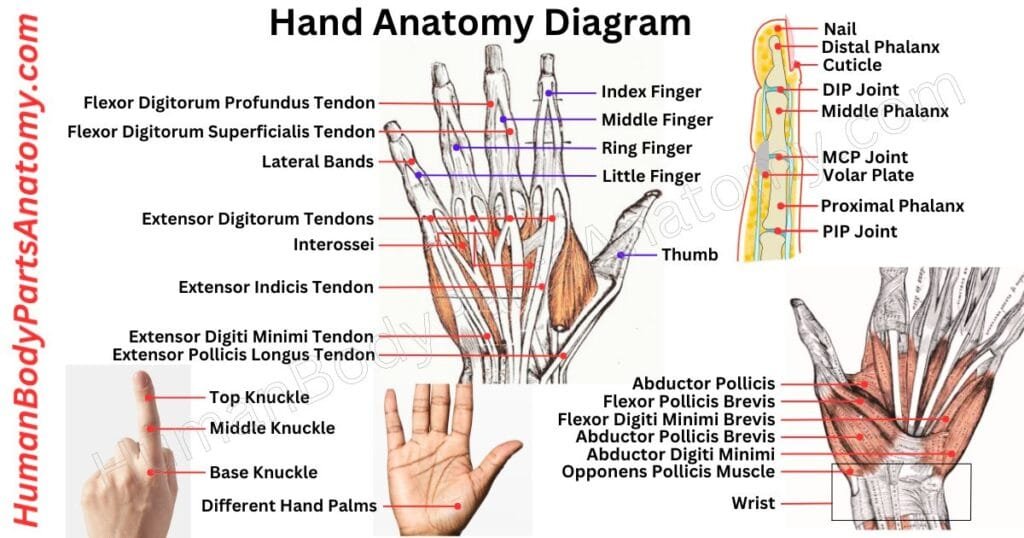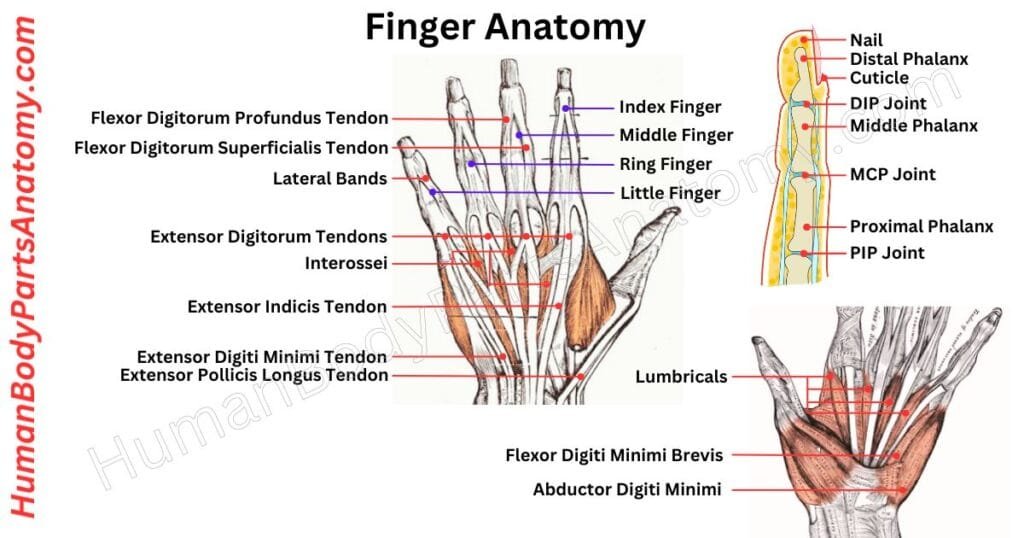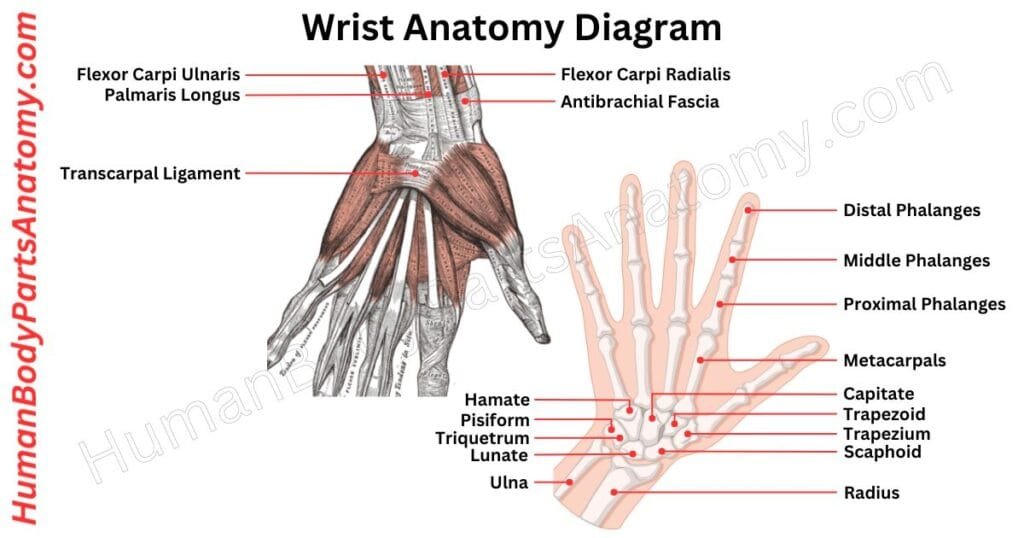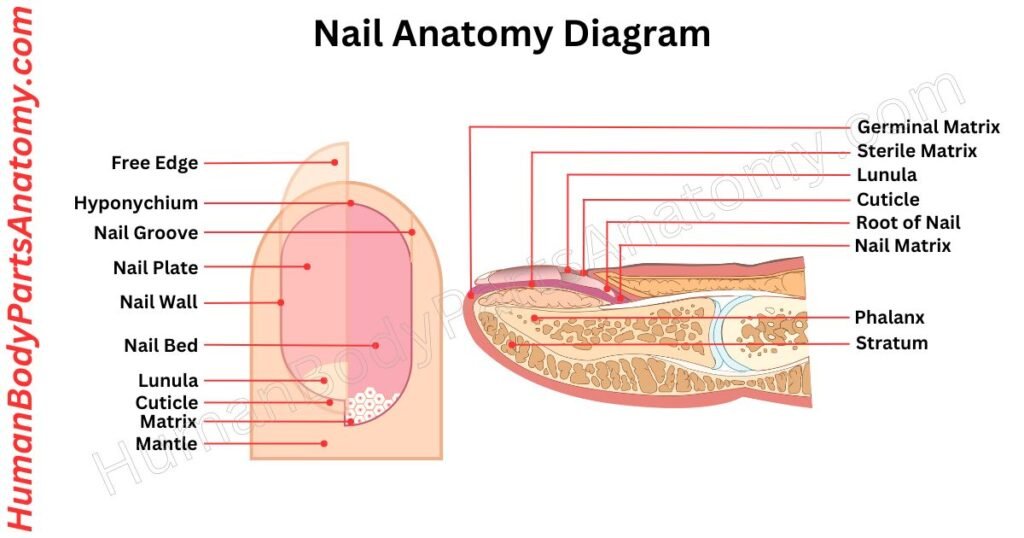📅 Published on March 9, 2024 | 🕒 Last updated on November 2, 2025
Overview of Hand Anatomy
The human hand is one of the most important and versatile parts of the upper limb.[1] It is designed for both strength and precision, allowing us to feel, grasp, hold, and move objects with remarkable control.[1] From performing powerful actions like lifting or climbing to delicate tasks such as writing, typing, or handling tiny objects, the hand adapts to nearly every activity we do.[1] The human hand anatomy is composed of bones, joints, muscles, tendons, ligaments, nerves, and blood vessels.[1] The intrinsic muscles of the hand play a key role in fine movements.[2] The forearm muscles also extend tendons through the wrist, enabling a wide range of precise and complex motions. This unique structure makes the hand one of our body’s most important parts for interacting with the world.[1]
In this article, we will examine the various parts of the hand, their functions, and their significance in everyday life. This article also provides a detailed overview of the anatomy of the hand that is useful for students, medical learners, and anyone curious about how the human body works.
Hand Anatomy Diagram

Anatomy of the Hand
Internal Parts of a Hand
- Bones
- Phalanges
- Metacarpals
- Carpals
- Joints
- Ligaments
- Muscles
- Synovial lining
- Volar plates
- Tendon sheaths
- Tendons
- Blood vessels
- Nerves
- Palmar fascia
External Parts of a Hand
- Fingers
- Thumb
- Index finger
- Middle finger
- Ring finger
- Little finger
- Palm
- Wrist
- Knuckle
- Fingernail
Hand Anatomy – Parts & Functions
Hand Bone Anatomy
The skeletal system is an important framework of the human body. It provides structure, protection, and support to essential organs and tissues.[3]
Among the 206 bones in the body, the bones in the hands are especially important because they allow for a wide range of precise movements. These bones, joints, and muscles help grip, hold, and manipulate objects with great accuracy and control.[3]
This strong foundation is necessary for the hand to maintain shape and stability. The parts of the hand benefit from the strength and rigidity of bones, which act as an internal framework to ensure optimal performance.[3]
1. Phalanges
Phalanges are the small bones that make up our fingers and toes.[3] There are 14 in each hand and foot. These bones get their name from the Greek, meaning “finger or toe bone.”
Each finger and toe has three phalanges: proximal (closest to the hand or foot), middle, and distal (farthest from the hand or foot). However, the thumb and big toe are unique—they only have two phalanges, missing the middle one.[3]
The distal phalanx is the bone at the tip of each finger and toe. It supports the nail and is shaped in a way that starts wide at the base, narrows, and then flares out slightly at the tip, forming a small bump.[3]
2. Metacarpals
The metacarpus is made up of five long bones that connect the wrist to the fingers. These bones are numbered from 1 to 5, starting from the thumb side.[3]
Each metacarpal has a shaft, with a broad base near the wrist and a rounded head that connects to the finger bones. On the back of the hand, where the knuckles form, a flat, triangular area becomes visible just before the fingers.[3]
The knuckle’s raised prominence comes from the rounded heads of the metacarpal bones, which meet the finger bones at the metacarpophalangeal joints.
The palm side of the metacarpals has concave regions where the palm muscles are positioned, providing the strength and movement needed for gripping and manipulating objects.[3]
3. Carpals
The wrist contains eight small carpal bones organized into two rows, supporting flexibility and strength. The first row, near the forearm, includes the scaphoid, lunate, triquetrum, and pisiform bones.[3]
These bones form the foundation of the wrist’s connection to the arm. The second row, closer to the hand, consists of the trapezium, trapezoid, capitate, and hamate bones.[3]
These bones are essential for smooth hand and wrist movements, supporting nearby muscles and ligaments. They also create passages for important nerves and blood vessels, contributing to the wrist’s overall function and stability.[3]

Read More – Complete Guide to Finger Anatomy with Parts, Names, Functions & Diagram
- What are the Finger Injuries and Disorders?
- What is a Trigger Finger?
- Different Finger pain? Causes & Care.
- What is Smashed fingers?
- What is webbing of the fingers or toes?
Hand Anatomy – Joints
With the help of different hand joints, we can carry out many actions accurately and skillfully. They allow us to perform intricate movements with precision and accuracy.[4]
These specialized areas, where the phalanx bones connect, provide support and flexibility. They are necessary for bending, straightening, twisting, and grasping objects.[4]
There are various types of joints, and each with a unique function. The hinge joint at the base of each finger facilitates smooth bending and straightening movements.[4]
1. Wrist Joint
One critical synovial junction is the radiocarpal joint. It connects the scaphoid, lunate, and triquetral, tiny wrist bones, to your forearm bone (radius).[4]
It allows you to move your wrist up, down, and side to side. The lower end of the radius generates a substantial concave surface at the radiocarpal joint, which interacts directly with the scaphoid and lunate bones. This joint facilitates a wide range of wrist motions, which include grasping, raising, and rotating the hand.[4]

Read More – Wrist Anatomy: Ultimate Guide to Parts, Names, Functions & Diagram
2. Carpometacarpal Joint
The carpometacarpal (CMC) joints connect the wrist to the bones of the hand, forming an important link for both mobility and stability. There are five CMC joints, each playing a unique role in hand movement.[5]
The joint at the base of the thumb is the most versatile and allows for a wide range of motion, which enables actions like gripping and pinching.[5]
The other four CMC joints, which connect the middle bones of the hand (metacarpals) to the wrist (carpal) bones, offer varying degrees of movement.
Those closer to the thumb, like at the base of the index finger, provide more flexibility, while the ones near the little finger are more rigid.[5]
It balances strength and flexibility by helping the hand maintain stability during tasks like gripping or lifting while allowing precise movements where needed.[5]
Hand Ligament Anatomy
The human hand relies on a network of ligaments to maintain its structure, stability, and precise movements. These ligaments prevent injury and allow smooth, controlled motion in daily activities.
1. Collateral Ligaments:
It is on the sides of the fingers and thumb, and prevents excessive sideways movement. They keep the digits aligned during motion, ensuring precision while gripping, holding, or manipulating objects.[6]
2. Volar Plate:
It is on the palm side, beneath the finger joints. The volar plate stops the fingers from bending backward too far. This protective structure prevents hyperextension and reduces the risk of joint injury.[6]
3. Palmar Fascia:
A thick, triangular layer beneath the skin of the palm. The palmar fascia maintains the hand’s shape during movement. It also prevents the skin from slipping while gripping objects, enhancing hand efficiency.[7]
4. Ulnocarpal and Radiocarpal Ligaments:
These ligaments stabilize the wrist joint by connecting the forearm to the hand. They allow controlled and smooth wrist motion, which is essential for tasks requiring strength and precision.[4]
5. Volar Carpal Ligaments:
It is on the underside of the wrist. The volar carpal ligaments provide additional support during wrist movements, helping maintain joint stability.[4]
6. Dorsal Radiocarpal Ligaments:
It is on the back of the wrist. These ligaments stabilize the wrist during extension and protect it when bending backward, ensuring a balance of flexibility and strength.[4]
Together, these ligaments form a complex support system that keeps the hand stable, flexible, and capable of delicate, coordinated movements. Proper ligament function is essential for everyday activities and prevents hand injuries.[6]
Hand Muscle Anatomy
The hands contain 34 muscles, which healthcare providers categorize into distinct groups, each with its unique functions:
- Thenar muscles: These muscles control the movement of the thumb. They are located at the base of the thumb in the palm, and their contraction can be felt as a bulge in that area.[2]
- Hypothenar muscles are positioned along the outer edges of the palm; these muscles govern the region opposite to the thumb, particularly around the pinkie finger.[2]
- Interossei muscles are situated between the metacarpal bones within the palm, and interossei muscles facilitate side-to-side finger movements.[2]
- Lumbrical muscles: This muscle is found at the base of the four non-thumb fingers; lumbrical muscles aid in flexing the fingers.[2]
There are two main types of grip that our hand muscles help with:
- Power grip: This grip uses the strength of larger hand muscles to hold or move heavy objects, like when you’re lifting weights or twisting open a tight jar lid. It’s all about force and stability.[2]
- Precision grip: This grip involves the coordination between the fingers and thumb to handle smaller, delicate objects. It usually involves a pinching motion where the fingertips meet the thumb, like when you’re picking up a coin or turning a key.[2]
Apart from gripping, the muscles around the wrist help control different wrist movements:[2]
- Flexion: Bending the wrist towards the palm, like when you curl your hand inward.
- Extension: Raising the wrist upwards, similar to making a “stop” sign with your hand.
- Adduction: Moving the wrist inward toward the body’s center.
- Abduction: Turning the wrist outward, away from the body’s midline.
These movements, powered by different muscle groups, allow us to perform a wide range of tasks requiring strength and precision.
Synovial Lining
This extraordinary tissue produces the synovial fluid that keeps our joints moving quickly and painlessly. Without this priceless coating, our motion would be painful and uncomfortable, and our joints would be permanently harmed.[1]
The synovial fluid also provides essential nourishment to maintain the health and functionality of our cartilage.[1]
The next time you walk or bend your elbow, consider how unique your synovial lining is in enabling these actions.[1]
Volar Plates
The complex network of dense connective tissues known as the volar plates serves as vital support and stabilization for the joints in our fingers.[6]
These unusual structures stop the fingers from bending too far backward. It can prevent serious injuries or dislocations.[6]
The volar plates on the palmar side of the joints are made of thick, fibrous tissue. They offer a robust, solid framework to ensure appropriate alignment and integrity throughout the movement.[6]
These plates play a crucial role in the stability and mobility of the fingers. They have a robust construction that can endure much stress and strain.[6]
Without the volar plates, our fingers would be far more prone to injury, impairing our capacity to carry out routine activities quickly and accurately.[6]
These complex tissues balance the firmness and flexibility necessary for hand function.
Tendon Sheaths
Tendon sheaths are one of the crucial parts of the hand anatomy that contribute to this capacity to grab an item.[8]
The hand’s tendons are encased in these unique fluid-filled tubes, cushioning and reducing friction when the tendons pass through them.[8]
Tendon sheaths comprise two layers of connective tissue: the inner layer is a fragile synovial membrane, and the outer layer is thick fibrous tissue.[8]
A viscous fluid that the synovial membrane secretes lubricates the tendons, enabling them to move freely and painlessly.[8]
This lubricant ensures the pieces work together without resistance. It is similar to the oil required to keep an automobile engine operating smoothly.[8]
Sheaths around the tendons guide them as they pass through the hand. The sheath’s walls align the tendons, lowering the risk of damage by keeping them from rubbing against other hand structures.
Hand Anatomy – Tendons
Tendons are crucial tissues that connect muscles to bones, enabling movement in our hands. They are made mostly of collagen, a protein known for strength, flexibility, and durability.[9]
This structure allows tendons to withstand high levels of tension and strain, which is essential for the fine motor skills we use daily, like gripping objects, writing, and typing.[9]
What makes tendons remarkable is their ability to stretch and contract as needed while still being tough enough to handle repeated stress.[9]
Without them, muscles wouldn’t be able to generate the force necessary to move bones, making even simple tasks impossible. Their specialized design ensures the precise and efficient movements we rely on constantly.
Blood Vessels
The human hand is a unique organ that relies on a sophisticated blood artery network to supply and remove blood effectively. These blood veins provide the hand’s tissues with oxygen and nourishment. They also aid in controlling the hand’s temperature and maintaining fluid balance.[10]
Without this complex network of blood vessels, the hand could not carry out its wide range of tasks. It’s responsible for grasping and moving items.[10]
Therefore, the health and well-being of the hand and the body depend on the efficient operation of these blood arteries.
Nerves
The body’s nerves send and receive messages between the brain and other body parts, including the hands. These nerves enable us to sense various feelings and precisely regulate our actions.[11]
We can perceive the environment in real-time because neurons convey messages that move through the nerves at an extraordinary speed.[11]
Our bodily experience would be significantly diminished without nerves. We would not be able to interact with the outside world similarly.[11]
Palmar Fascia
The palmar fascia, a tough layer of soft tissue, is found in the palm of your hand. This complex, fibrous ring of connective tissue stabilizes the palm of your hand. It serves as a solid base for the complex motions that our hands can do.[7]
Our hands would only be as nimble with the support of the palmar fascia. We rely on it to perform various daily tasks. With it, our ability to do things is unlimited.[7]
Fingers
Fingers are vital parts of the hand that allow us to grip, hold, and manipulate objects.[1] This is possible because of their flexible structure, which includes small bones called phalanges.[3]
Each finger has three phalanges—except the thumb, which has two—and joints that enable them to bend and curl inward, forming a strong grasp.[3]

Read More – Complete Guide to Finger Anatomy with Parts, Names, Functions & Diagram
- What are the Finger Injuries and Disorders?
- What is a Trigger Finger?
- Different Finger pain? Causes & Care.
- What is Smashed fingers?
- What is webbing of the fingers or toes?
1. Thumb
The thumb is the thickest and most mobile finger. It plays a crucial role in grip and precision. Unlike other fingers, the thumb can move across the palm (a movement called opposition), allowing us to firmly hold items like pens, tools, or smartphones.[5]
In daily tasks such as typing or lifting, the thumb is essential for control and stability. In today’s digital age, where smartphone typing is ubiquitous, the importance of the thumb is further emphasized.[1]
2. Index Finger
The index finger, located next to the thumb, is important for precise movements. It works closely with the thumb during activities such as writing, drawing, and pointing. This finger is often the most used for interacting with touchscreens and other fine motor tasks.[1]
3. Middle Finger
The middle finger is the longest and centrally located finger on the hand. It contributes significantly to grip strength and helps distribute pressure evenly when holding or lifting objects.[1]
Biomechanically, it supports other fingers by acting as a stabilizing center during forceful hand movements.
4. Ring Finger
It is positioned between the middle and the little finger. The ring finger offers balance to the hand’s grip but is less independent in movement.[1]
Culturally, it is traditionally the finger used for wearing engagement or wedding rings, particularly on the left hand in many societies.[1]
5. Little Finger
The little finger, or pinky, is the smallest, but it plays a vital supporting role in strong grips. Although it contributes less to fine movement.[1]
It works with the other fingers to provide hand stability and complete the full range of motion needed for holding large or heavy objects.[1]
Palm
The palm is the broad inner surface of the hand that plays a key role in gripping. Its skin contains ridges and lines that improve friction, helping us hold objects securely.[1]
The palm connects to the fingers through flexible joints, allowing it to fold and support hand movement.[1]
Wrist
The wrist is a highly flexible joint that links the hand to the forearm.[4] It is made up of eight small carpal bones arranged in two rows.[3]
It allows the hand to bend, rotate, and move in multiple directions. This mobility makes the wrist essential for everyday tasks like writing, lifting, or turning objects.[4]
Knuckle
Knuckles are the bony prominences seen on the back of the hand where the fingers meet the palm. These joints, called metacarpophalangeal (MCP) joints, allow fingers to flex and extend.[6]
Knuckles also provide force during impact, which is why they’re important in activities like boxing or martial arts.[6]
Fingernails
Fingernails are hard, protective coverings found at the tips of fingers. They are made of keratin, a strong protein also found in hair.[1]
Nails grow continuously from the base, called the nail matrix, and help with delicate tasks like scratching, picking, or gripping small objects.[1]

Read More – Complete Guide to Nail Anatomy with all Parts, Names & Diagrams
FAQ’s
The human hand comprises 27 bones: 8 carpal bones (located in the wrist), 5 metacarpal bones (in the palm), and 14 phalanges (in the fingers).[3] These bones provide structure, stability, and mobility for hand movements.[3]
The hand has intrinsic muscles (within the hand, controlling fine movements like writing and gripping) and extrinsic muscles (originating in the forearm, providing strength for grasping).[2] Together, they enable precise and powerful hand functions.[2]
The hand contains several joints:
Metacarpophalangeal joints (MCP) – knuckles
Proximal interphalangeal joints (PIP) – middle finger joints
Distal interphalangeal joints (DIP) – fingertip joints
These joints allow bending, straightening, and gripping.[4]
Three main nerves supply the hand:[11]
Median nerve – controls thumb, index, and middle finger sensations and movements
Ulnar nerve – controls the little finger and part of the ring finger
Radial nerve – controls the back of the hand and wrist movements
Hand bones provide support, flexibility, and dexterity.[3] They enable gripping, holding, writing, and performing delicate tasks, while also supporting larger functions like lifting and pushing.[3]
The thumb is crucial because of its opposability—the ability to touch the tips of other fingers. This unique feature allows humans to grasp, hold, and manipulate objects with precision.[5]
Frequent hand injuries include fractures, sprains, dislocations, tendon injuries, and carpal tunnel syndrome. These can affect movement and require proper diagnosis and treatment.[12]
The hand receives blood mainly from two arteries:
Radial artery – supplies the thumb and lateral side of the hand
Ulnar artery – supplies the medial side of the hand
They form the palmar arches, ensuring good blood flow to all fingers.[10]
References-
- InformedHealth.org. (2025). In brief: How do hands work? National Center for Biotechnology Information (NCBI). Last reviewed January 23, 2025. https://www.ncbi.nlm.nih.gov/books/NBK279362/
- Lezak, A., et al. (2023). Anatomy, Shoulder and Upper Limb, Hand Muscles. StatPearls. National Center for Biotechnology Information (NCBI). Last updated July 2023. https://www.ncbi.nlm.nih.gov/books/NBK537229/
- Beks, R. B., et al. (2023). Anatomy, Shoulder and Upper Limb, Hand Bones. StatPearls. National Center for Biotechnology Information (NCBI). Last updated August 2023. https://www.ncbi.nlm.nih.gov/books/NBK547684/
- Hammoud, B., et al. (2023). Anatomy, Shoulder and Upper Limb, Hand, Radiocarpal Joint. StatPearls. National Center for Biotechnology Information (NCBI). Last updated October 2023. https://www.ncbi.nlm.nih.gov/books/NBK539744/
- Ladd, A. L., et al. (2022). First Carpometacarpal Joint Anatomy and Osteoarthritis. StatPearls. National Center for Biotechnology Information (NCBI). PMID: 35137205. https://www.ncbi.nlm.nih.gov/pmc/articles/PMC8817812/
- Hagele, H., et al. (2023). Anatomy, Shoulder and Upper Limb, Metacarpophalangeal Joints. StatPearls. National Center for Biotechnology Information (NCBI). Last updated November 2023. https://www.ncbi.nlm.nih.gov/books/NBK538428/
- Cleveland Clinic. (2023). “Anatomy of the Hand & Wrist: Bones, Muscles & Ligaments.” https://my.clevelandclinic.org/health/body/25060-anatomy-of-the-hand-and-wrist
- Varacallo, M., et al. (2023). Anatomy, Shoulder and Upper Limb, Hand Ulnar Bursa. StatPearls. National Center for Biotechnology Information (NCBI). Last updated October 2023. https://www.ncbi.nlm.nih.gov/books/NBK541025/
- Awan, K. M., et al. (2024). Anatomy, Tendons. StatPearls. National Center for Biotechnology Information (NCBI). Last updated May 1, 2024. https://www.ncbi.nlm.nih.gov/books/NBK513237/
- Bordes, S. J., et al. (2023). Anatomy, Shoulder and Upper Limb, Hand Arteries. StatPearls. National Center for Biotechnology Information (NCBI). Last updated November 5, 2023. https://www.ncbi.nlm.nih.gov/books/NBK546583/
- Reed, D., et al. (2023). Anatomy, Shoulder and Upper Limb, Hand Cutaneous Innervation. StatPearls. National Center for Biotechnology Information (NCBI). Last updated September 2023. https://www.ncbi.nlm.nih.gov/books/NBK544247/
- National Library of Medicine (NIH). (2023). “Hand Injuries and Disorders.” MedlinePlus. https://medlineplus.gov/handinjuriesanddisorders.html
Read More-
Lower Limb
- Hip Bone Anatomy – Complete Guide with Parts, Names, Functions & Diagram
- Complete Guide on Leg Anatomy with Parts, Functions & Diagram
- Complete Guide to Thigh Muscle Anatomy: Learn Parts, Names & Diagram
- Knee Anatomy: Complete Guide to Parts, Names, Functions & Diagram
- Femur Anatomy: Complete Guide with Parts, Names, Functions & Diagram
- Hip Muscle Anatomy – Complete Guide with Parts, Names, Functions & Diagram
Upper Limb
- Complete Guide to Finger Anatomy with Parts, Names, Functions & Diagram
- Complete Guide to Forearm Anatomy: Parts, Names, Functions & Diagram
- Comprehensive Guide to Arm Anatomy: Parts, Names & Diagram
- Comprehensive Guide to Hand Anatomy: Parts, Functions & Diagram
- Ultimate Guide to Bicep Anatomy: Parts, Names, Functions & Diagram
- Shoulder Anatomy: Ultimate Guide to Parts, Names, Functions & Diagram
- Wrist Anatomy: Ultimate Guide to Parts, Names, Functions & Diagram
- Complete Guide to Nail Anatomy with all Parts, Names & Diagrams
- Spine Anatomy: Complete Guide with Parts, Names, Functions & Diagram
External Sources-
- Wikipedia
- KenHub
- Optometrists
- Cleveland Clinic
- American Academy of Ophthalmology
Official websites of the United States government.
- What is Hand Injuries and Disorders?
- What is Claw hand?
- How to perform a hand X-ray?
- What is Chapped hands?
Medical Disclaimer
All content on HumanBodyPartsAnatomy.com is educational and based on verified, peer-reviewed medical sources. Articles are authored or reviewed by qualified medical or biomedical professionals to ensure accuracy.
This website does not provide medical advice, diagnosis, or treatment. Always consult a licensed healthcare professional for personal medical guidance.
No commercial or promotional interests influence the medical content published on this site.

